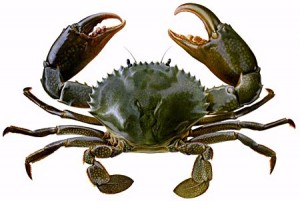Mud Crabs or Mangrove Crabs and also known as Alimango in the Philippines, are large crabs with a smooth, broad carapace. Their two hind legs are flattened for swimming. In the most common form, the shell color varies from very dark brown to mottled green. The other, generally smaller form has a deeper body and is reddish brown.
Mud Crabs cooked with their shells on, when they moult their shells, they can be served as a seafood delicacy, one of many types of soft shell crab. Some consider them to be among the tastiest of crab species and they have a huge demand in the countries where they are often bought alive in the local markets and also exported.

Kinds of Mud Crabs
Not all of the mudcrab raisers know which kinds of mudcrabs are the best one to raise because they all look the same at a glance. But most of us are unaware that there is a very high quality and most expensive type of Scylla or giant mud crabs or king of crabs. There are four kinds: Scylla serrata, Scylla olivacea, Scylla traquebarica and Scylla paramamosain.
The Scylla serrata species are the favorite one of farmers because it is easy to raise and fatten. They grow faster than the rest. They weight as much as 1 kilogram each after six months. If the feeding is regular they will thrive in a pond with no problem and seldom you can see them dig burrows in the mud so the dikes will not be damaged.
The baby crabs or crab seeds are caught by fishermen by the sea side and they sell it to fishpond operators. Then the mud crabs are raised in brackish water. You can combine them along with milkfish if you are raising it too but never put mud crabs on the prawn pond because mud crabs will eat the prawns. It is important that you have a steady supply of mud crab seed to your crab farm.
How to raise Mud Crabs
Mud Crabs Fattening
A. First Method:
- Choose a good pond with ample supply of brackish water, 10-20 part per thousand(ppt) salinity.
- Be sure that the soil is muddy and sandy, not sticky.
- Make a bamboo fence two meters high. This is for the fence around the pond. Push the fence to the ground two inches deep so it will stand up. From the opening of the dike, make a bamboo screen so the mud crabs will not escape.
- Then water the pond. It should have a good running water in order maintain the clean water supply.
- Then put the crab seed with the ratio of 2,000 – 5,000 pcs per hectare.
- There is no problem in feeding because the crab fry will eat moss growing on the pond.
- To the growing crabs, feed them with small fishes called trash fishes 5- 8 % depending on the crabs’ weight. Weigh the crabs every 20 days to know the amount of food to be given.
- You can harvest it after 90 – 120 days.
B. Second Method:
- Choose a pond with brackish water of 10 -20 ppt salinity.
- Make a bamboo cage 1 foot high and 1 foot length and width.
- In every cage put a mudcrab weighing 150 – 200 grams. Put the cage with the mudcrab in the fish pond within 15 days.
- Feed the crabs 2 times a day with 10 – 20 grams of trashfishes ( morning and afternoon). Increase the amount if necessary.
- After 15 days, you will notice that the shell on its’ back or carapace is measuring 12 – 15 centimeters across. The crabs are weighing 250 – 300 grams and this is the time that they are ready to be harvested and sold.
C. Harvesting:
- When the crabs weighs ½ to 1 kilograms each, they are ready to be sold.
- Use trap, hooks, scissor nets or gill net when catching the crabs.
- The crabs are sold alive and will live up to seven days with water just make sure that the container is cool and occasionally pour water.
- Tie the pair of claws near the abdomen with dried or plastic straw.
Source: Dept. of Agriculture; Photos: tradeindia.com, reef.crc.org.au